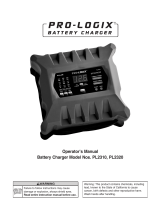
Page 4 ;&(%$*4.8"4,7%<'*#$"&8#=%/7*,#*%4,77%>?@@@?@AA?BCDC1 Item 60581
EF;6GH IJ6KFGLIM NFLMG6MFMO6EJ6OL;LOFGLIME
h. Use charger for charging a LEAD-ACID battery
only. It is not intended to supply power to a
low voltage electrical system other than in a
starter-motor application. Do not use battery
charger for charging dry-cell batteries that
are commonly used with home appliances.
These batteries may burst and cause injury
to persons and damage to property.
i. NEVER charge a frozen battery.
12. PREPARING TO CHARGE
a. If necessary to remove battery from vehicle
to charge, always remove grounded terminal
from battery first. Make sure all accessories in
the vehicle are off, so as not to cause an arc.
b. Be sure area around battery is well
ventilated while battery is being charged.
c. Clean battery terminals. Be careful to keep
corrosion from coming in contact with eyes.
d. Add distilled water in each cell until battery
acid reaches level specified by battery
manufacturer. Do not overfill. For a battery
without removable cell caps, such as valve
regulated lead acid batteries, carefully follow
manufacturer’s recharging instructions.
e. Study all battery manufacturer’s
specific precautions while charging and
recommended rates of charge.
f. Charge battery initially at lowest rate.
13. CHARGER LOCATION
a. Locate charger as far away from
battery as DC cables permit.
b. Never place charger directly above
battery being charged; gases from battery
will corrode and damage charger.
c. Never allow battery acid to drip on
charger when reading electrolyte
specific gravity or filling battery.
d. Do not operate charger in a closed-in
area or restrict ventilation in any way.
e. Do not set a battery on top of charger.
14. DC CONNECTION PRECAUTIONS
a. Connect and disconnect DC output clips only
after removing AC cord from electric outlet.
Never allow clips to touch each other.
b. Attach clips to battery and chassis as indicated
in 15(e), 15(f), and 16(b) through 16(d).
15. FOLLOW THESE STEPS WHEN BATTERY
IS INSTALLED IN VEHICLE. A SPARK NEAR
BATTERY MAY CAUSE BATTERY EXPLOSION.
TO REDUCE RISK OF A SPARK NEAR BATTERY:
a. Position AC and DC cables to reduce risk of
damage by hood, door, or moving engine part.
b. Stay clear of fan blades, belts, pulleys, and
other parts that can cause injury to persons.
c. Check polarity of battery posts. POSITIVE
(POS, P, +) battery post usually has larger
diameter than NEGATIVE (NEG, N,–) post.
d. Determine which post of battery is
grounded (connected) to the chassis. If
negative post is grounded to chassis (as
in most vehicles), see (e). If positive post
is grounded to the chassis, see (f).
e. For negative-grounded vehicle, connect
POSITIVE (RED) clip from battery charger
to POSITIVE (POS, P, +) ungrounded post
of battery. Connect NEGATIVE (BLACK)
clip to vehicle chassis or engine block
away from battery. Do not connect clip to
carburetor, fuel lines, or sheet-metal body
parts. Connect to a heavy gauge metal
part of the frame or engine block.
f. For positive-grounded vehicle, connect
NEGATIVE (BLACK) clip from battery charger
to NEGATIVE (NEG, N, –) ungrounded post of
battery. Connect POSITIVE (RED) clip to vehicle
chassis or engine block away from battery.
Do not connect clip to carburetor, fuel lines, or
sheet-metal body parts. Connect to a heavy
gauge metal part of the frame or engine block.
g. When disconnecting charger, disconnect AC cord,
remove clip from vehicle chassis, and
then remove clip from battery terminal.
h. See operating instructions for
length of charge information.
16. FOLLOW THESE STEPS WHEN BATTERY
IS OUTSIDE VEHICLE. A SPARK NEAR THE
BATTERY MAY CAUSE BATTERY EXPLOSION.
TO REDUCE RISK OF A SPARK NEAR BATTERY:
a. Check polarity of battery posts. POSITIVE
(POS, P, +) battery post usually has a larger
diameter than NEGATIVE (NEG, N, –) post.
b. Attach at least a 24-inch-long 6-gauge
(AWG) insulated battery cable to
NEGATIVE (NEG, N, –) battery post.
c. Connect POSITIVE (RED) charger clip to
POSITIVE (POS, P, +) post of battery.
d. Position yourself and free end of cable
as far away from battery as possible
– then connect NEGATIVE (BLACK)
charger clip to free end of cable.
e. Do not face battery when
making final connection.
f. When disconnecting charger,
always do so in reverse sequence of connecting
procedure and break first connection while
as far away from battery as practical.
g. A marine (boat) battery must be removed and
charged on shore. To charge it on board requires
equipment specially designed for marine use.




















